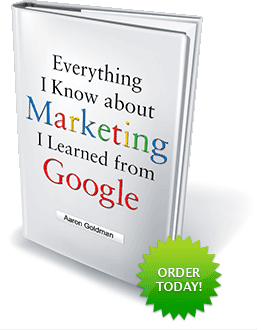I did a little Q&A with Dan Butcher from Mobile Marketer for his piece on “Can Google Make Money from Mobile?”
Here’s the full transcript…
What is your take on Google’s mobile strategy, and how it fits into its overall plans for generating revenue?
Mobile is a huge opportunity for Google. Eric Schmidt has said over and over that the mobile advertising market will be bigger than the “fixed” web. That’s why Android is getting so much attention. And that’s why Google threw down $750 million for AdMob.
In my book, chapter 5 talks about being where your audience is. Google’s audience is anyone using the Internet. Every day, more and more people are accessing the Web from their mobile devices. Therefore, Google needs to be there.
Android allows Google to control the user-experience and make sure search is front and center so it can make money off search ads. And AdMob allows Google to cash in on ads via mobile sites and apps.
Given that Android is open source, how does having a mobile operating system benefit the company’s bottom line?
The bottom line revenue impact for Android is primarily through search ads. By having direct access to mobile users, Google can make sure search is always baked into the experience. And if Apple were to lock out AdMob or change the search default to Bing on the iPhone OS, Google wouldn’t be totally screwed.
At some point, every business will have a mobile app, the way every business today has a website. If Google can get the millions of mom and pop advertisers that buy search ads on the fixed web to buy ads on the mobile web, the long tail revenue will be huge. The first step towards that is helping these businesses create mobile assets. Open-source is key and Google App Inventor is a great example of how to convert the mom and pops.
Will Google be as successful monetizing mobile search as it has been monetizing search via PCs?
Yes. The key to PC-search for Google is having a large enough pool of advertisers that it can show a relevant ad (or 10) for every possible query. That makes it a good user-experience. If the ads aren’t relevant, people won’t click.
Beyond just mobile web search though, there are opportunities for Google to put relevant ads in SMS, Voice, and Image search. These formats really take advantage of the unique features of mobile.
What companies do you see as Google’s main competitors in the mobile space, and what are Google’s prospects for success going forward?
Apple is the one I’d be most concerned about if I were Google. Sure Microsoft is a player and the Bing mobile search app is nice. But, just like with the fixed web, Bing’s still playing catch-up and copycat.
Apple on the other hand is taking a totally different approach. Now I’m not in love with iAd but I do think that format has legs for brand advertisers. What I am in love with is Siri, the “virtual personal assistant” that Apple bought back in April.
In chapter 21 of my book I talk about the potential for app-ssistants like Siri to supplant search. Rather than do a bunch of search queries to plan a trip or a date night, you can just send one instruction to your app-ssistant and get back a personalized itinerary based on your preferences.
If I’m Google, the idea that someone might skip me completely in the process of performing this kind of commercial transaction would definitely be keeping me up at night. That said, I have no doubt Google will find a play in the world of app-ssistants and I explore a few different paths it may take in my book.











